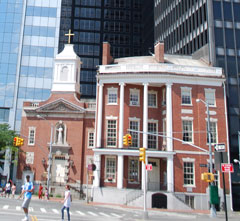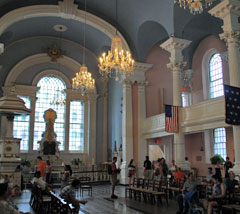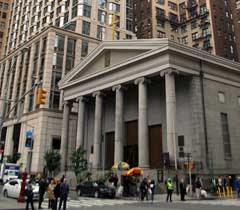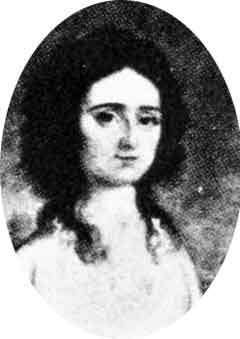A Saint Witnesses History
As a young New York socialite in a city that was capital of the U.S. in the 1790s, Betty Seton certainly knew George Washington. In fact her husband, William, organized a birthday party for the first president. And you know what? It wouldn't surprise me if Duncan Fyffe had a furniture sale. William Seton was in the shipping business and seems to have been set down by history as an incompetent who lost his fortune. Certainly his business was affected by turmoil in France and by Barbary Pirates disrupting shipping in the Mediterranean. These pirates were Islamic corsairs, much like those who harass ships today, but they were government-sponsored by among others, the rulers in present-day Libya. President Thomas Jefferson finally cracked down on the Barbary States in 1804-05, sending Marines to the shores of Tripoli. While it was too late for the dying William's business, the action enabled the Setons to travel to Italy and widow Betty to return home with conversion to Catholicism smoldering in her heart. While the Founding Fathers devoutly wished that there would be no political parties, the latter arose quickly in the young republic. One faction, which included John Adams, was in favor of strong central government; the other, which Thomas Jefferson led, favored decentralized power. The newly married Setons' New York neighbors included the Alexander Hamiltons. Hamilton was, like Adams, a Federalist. Among those who abhorred the rise of political parties was fifth president (1817-1825) James Monroe. As minister to France during the 1790s revolution, Monroe rescued many from execution including a priest, Fr. John Dubois, whom Monroe brought to Virginia. There the Frenchman was taught to speak English by an aged Patrick Henry. Dubois joined The Sulpician Fathers, the French order second only to the Jesuits in establishing the American Catholic Church. In 1805 he began building "St Mary-of-The-Hills" chapel and a boys' school on a mountainside near the Maryland/Pennsylvania border where many Catholics had fled in colonial times to worship unmolested. The name of the school, "Mont St. Marie" was anglicized to "Mount St. Mary's." In 1808, Elizabeth Ann Seton and her maiden sisters arrived to set up the girls' wing of the new institution. Mother Seton kept in constant written touch with friends in the major U.S. cities and in Europe. Of course, it took weeks for letters to be delivered domestically and months for them to cross the ocean. As she posted her genuine expressions of friendship, Betty hoped that the recipients' responses would include "some 'shiners' for us." The friends often took the hints and outright requests and sent enough money to keep the school going. When the Napoleonic conflict and War of 1812 made communication with friends and children spotty, the frustrated foundress declared, "The mail is crazy!" "The menacing aspect of public affairs" When war was declared against Great Britain in June of 1812, rioting broke out in Baltimore, as it often did in American cities then. Many were killed. Betty Seton's ten-year-old daughter, Rebecca, who was already feeling the effects of tuberculosis, was in Baltimore being treated for the illness and staying with friends, the Catons. Bec was evacuated to Emmitsburg by carriage. Two years later, near the war's end, the British burned Washington, but they were repelled from a land and water invasion of Baltimore. Because of what Mother described as "the menacing aspect of public affairs," in September, 1814, Sisters of Charity were sent to Philadelphia overland, by way of York and Lancaster, rather than through the Chesapeake Bay. In those days, travel by water was faster and more comfortable. Betty Seton stated that she did not understand politics. However she did read the newspapers and believed that presidents and former presidents should be treated with respect. In 1816 some very partisan publications were hammering Thomas Jefferson as they had in the past. It may have been over the government bail-out that the ex-chief got. 1816 was the year Congress purchased the indebted Virginian's Monticello book collection to start The Library of Congress. After hearing giggling students in her class read some printed ridicule that "make Mr. Jefferson out to be a ... Gilpin(1), " Betty was shocked that the "government could countenance such a press freedom." There is no record of whether or not she took the paper off the kids. "The trouble of banks." In 1819, when even her wealthiest friends had to cut back on donations, Betty wrote of "the trouble of banks." She was referring to what historians now call "The Panic of 1819." You learned about Eli Whitney's cotton gin. That machine made harvesting cotton practical and gave new life to the practice of slavery. By the 1810s, cotton had become a bubble being enlarged by speculation. Up and up the price of this American commodity went as it was sold around the world, particularly to the new cotton mills in England. Came 1818 and suddenly there was too much cotton, more than the mills could use. The price began falling. English bankers stopped lending to American banks, which began calling in their debts. A credit and financial crisis spread. At the center was the already-controversial Bank of The United States. Talk of financiers having too much power would become louder throughout the 1820s and '30s. The panic was the first of American depressions. It was something new for people to lose everything because of financial tangles and events that occurred thousands of miles away. Historian Daniel Walker Howe has written that for Americans, "It was profoundly disturbing that a change in personal fortunes could be unrelated to personal merit." (2) 1819 was also the year that Mount St. Mary's nearly closed. Fr. DuBois was a "builder," a not uncommon type in church history who spends lavishly on infrastructure. The Sulpicians felt that he might be spending too much and moved to close the institution. The archbishop, Ambrose Maréchal, was himself a Sulpician. However the farmers and townspeople of the Emmitsburg area offered a whopping $8,000-10,000 to buy the school, if necessary, to keep it open. Who knows where the "country peeps," as the saint called them in correspondence, got that kind of money, but the archbishop and the Sulpicians backed off. ------------------------------------------- (1) "Gilpin" probably means "a man out of control," in Jefferson's case, with his finances. The word "gilpin" comes from a popular, circa 1800 ballad about a man riding a runaway horse that he couldn't rein. (2) What hath God Wrought: The Transformation of America, 1815-1848, Daniel Walker Howe, Oxford University Press, 2007 |
 |
|---|
| Just across State Street from the Staten Island Ferry Terminal is the last New York house occupied by Will and Betty Seton before they left for Italy in 1804 in hopes of solving their financial and health problems. The Setons were going downhill moneywise when they moved into this place. Given the perennial pressures of New York real estate, it's a miracle that the house has survived. |
 |
| Much of the drama of Betty Seton's conversion to Catholicism took place within a couple blocks of the present day World Trade Center site. Above is the interior of St. Paul's Episcopal Church. Betty sat in the balcony at right so she could look out the window at St. Peter's Catholic Church one block away. |
 |
This is not the original St. Peter's at Church and Barclay Streets where Betty came to the church. This enlarged St. Peter's was built 1836-38, however its altar piece, a Mexican painting of the crucifixion, is the one Betty prayed in front of in 1805-06. Sometimes her girlfriends would come with her to see "the naked Jesus." There were such things as "Gangs of New York" and at Christmas of 1806, an anti-Catholic group called the "High-Binders" caused two days of riots around St. Peter's in which one constable (law enforcement officer) was killed. Mother Seton's conversion was cited as one of the reasons these morons attacked, but she had come over a year earlier. |
Also by Neal J. Conway: |
- Copyright 2012 by Neal J. Conway. All rights reserved.
About this site and Neal J. Conway
nealjconway.com: Faith and Culture Without The Baloney
